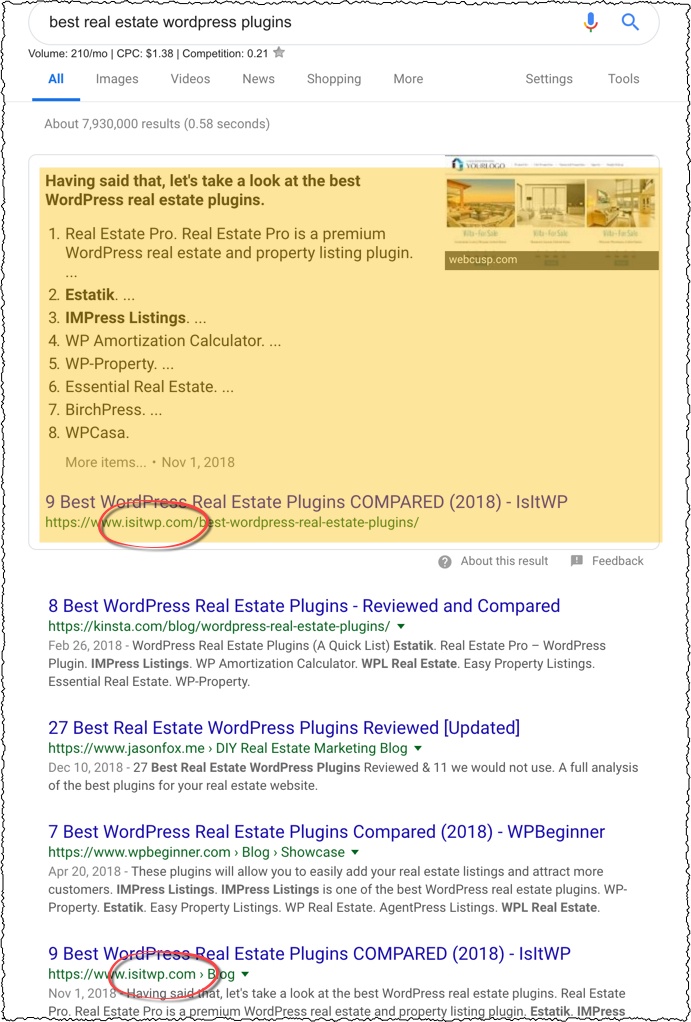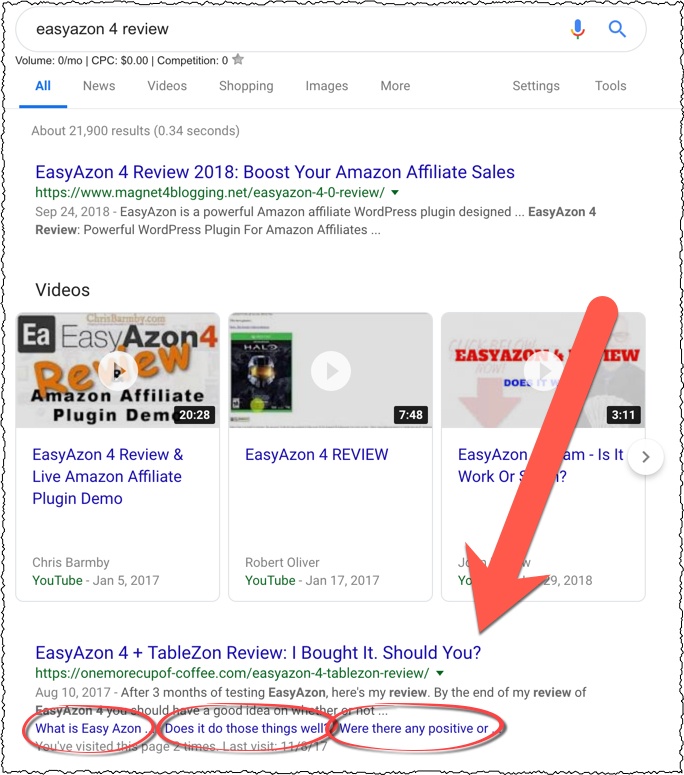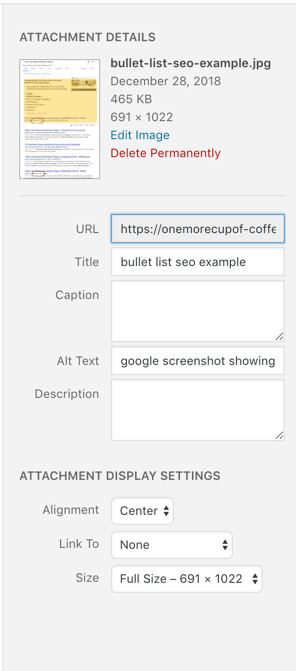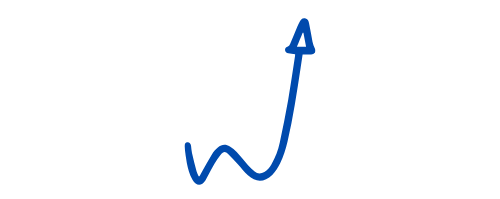SEO can be as complicated or as simple as you want it to be. I’m a firm believer that to make money online, you do NOT need any special SEO strategy. What you really need is knowledge of a topic, and a passion to help people. With those two ingredients, you’ll happily plunk away at the keyboard for hours, and in your pursuit of a higher purpose, money will follow.
That being said, with some knowledge of SEO, you could speed up your timeline of earning a full time income online significantly. With the foundation of a great idea, and a few tweaks to make your content “optimized” for search engines, you’ll get found faster, with better rankings, and more accurately matched up to what people are searching for. My SEO checklist will give you a basic rundown between “Here’s What I Ate For My Healthy Breakfast Today”, and “10 Keto Friendly Breakfast Recipes Without Eggs”.
Furthermore, it’s real easy to get caught up in the SEO world and worry about tiny details that don’t matter much. Many SEO guides will have you believe that there are hundreds of things you should be doing every time you publish content in order to get ranked. This isn’t really true. Actually, most SEO guides only work some of the time. The truth is, nobody knows exactly how Google’s algorithm works, so even the most confident SEO is still doing guesswork to some degree.
When you consider the constantly changing landscape of search engine algorithms, competition, publishing platforms, and social media, it’s very difficult to have an exact SEO strategy that will work forever and produce consistent results.
That’s why I take a broader approach to search engine optimization. Rather than focus on the details of Step 1, 2, and 3, I simply try to aim for the middle, do my best, and move on. Sure, some SEO professionals would mock that statement and explain to me how I need tier 2 backlinks with a 1.5% keyword density and a Domain Authority of 75 to rank for Keyword X. Whatever, man. That sounds like a lot of hassle to me, and you still can’t guarantee page 1 rankings.
I’d rather focus on creating awesome content people want to naturally link to, share, and engage with. I can spend an hour sourcing a backlink, or I can write another blog post and share it on social media. No, I don’t rank all the time. Yes, it’s still a lot of work. But it works for me, and it means I get to focus on the parts of my business I enjoy.
So, here’s my basic SEO checklist. You don’t have to do ALL of these items for every single piece of content you publish. With the exception of keyword in the title and keyword in your first paragraph, pretty much everything else is optional, and you can experiment with your own niche to see what works for you.
-
- 2018 Checklist (Still Relevant 2019,2020,2021,2022!)
You will find many videos discussing the broad overview of what you should be aiming to do in order to rank in Google. In the article below, you’ll find much more detail about specific action you can take on your content!
Build An Income-Generating Website That Lasts Decades!
Earn online income for a lifetime.
>>Start Now>>
Keywords: The Core Element To Your Content
- longtail keyword
- keyword placement
- LSI keywords
Stylized Text: Easy To Do And Overdo
- bullet/numbered lists
- h3 h4headings
- text formatting (bold/italics/underline)
Links For SEO: Are They The Most Important?
- internal links
- external links
- jump links
- backlinks
Multimedia: That Extra 10%
- videos
- image SEO
- social proof
Bonus Tip (scroll down to see)
Keywords: The Core Element To Your Content
Keywords are the main focus, or “concept” for your content. They’re more than just traffic and competition numbers. These are the things people are searching for online.
Longtail Keywords
If you learn one thing about SEO, it should be how to find a good keyword. The phrase you’ll hear over and over again is “longtail keywords”, basically meaning a long phrase. That phrase should be the focus of your article.
For example, don’t use keywords like “best barbecue” or “how to make money online”. Instead, use phrases like “best stainless steel pellet smoker barbecue grill combo” or “how to make money online dropshipping without a laptop”.
It’s very difficult, especially for new online entrepreneur, to find the line between a low-competition phrase, and a phrase that’s just too specific to be worth your time. This is a skill and intuition that will come with practice.
An obvious example would be this: “how to make money online without a laptop in winter 2018” is simply too specific. There’s no audience for it. “How to grill pork ribs on a Traeger stainless steel pellet grill” would fall under the same category.
There has be an audience for your keyword, but it has to be specific enough that you reach out to one exact type of customer. The best advice I can think of right now is to think about how the audience reading your current content is different from another audience. For example, someone barbecuing in winter on a Traeger smoker probably won’t have much difference from someone using a Weber smoker. It’s a different brand, but same basic concept. Therefore, you shouldn’t segment your audience that way.
However, barbecuing in the winter is different from barbecuing in the summer. A good article could be “Grilling on coal in the winter” since it’s a unique set of steps in comparison to grilling in the summer. Another audience segmentation could be grilling with coal vs pellets. So “How To Grill Use Your Pellet Grill In Snowy Weather” could be another article title.
Even if it doesn’t make perfect sense right now, finding keywords with a precise audience should be at the forefront of your mind as you create content for your website.
Keyword Placement
Where to put your keywords is a lot easier to talk about!
- Keyword in the title
- Keyword in the URL slug
- Keyword in the first paragraph
- Keywords with stylized text & headings
- Keywords in multimedia
It’s important to establish early on what the focus of your article is about. The sooner you talk about it, the more relevant it is. This is a good example of search engine “optimization. Sure, some styles of writing allow for creativity, like writing a long, hook-style introduction which reveals the true nature of the article several paragraphs down. While humans may enjoy that (and it could work for social media), in order for Google’s algorithms to rank you properly, you need to be pretty explicit about what you’re talking about.
Beyond those five rules, just write your article naturally. Too much keyword emphasis in an article, and you’ll risk running into keyword stuffing, if not just wasting your time.
A great example of this relevancy rule is in the title of your article.
If your keyword is “sports drinks with beta alanine”, which title is better?
- How Sports Drinks With Beta Alanine Can Make Your Gym Sessions More Fruitful”
- In The Battle Of Performance, Could Sports Drinks With Beta Alanine Be The Secret Better Workouts?
The answer is #1. See how the keyword appears early on? That means it’s more relevant, and increases your chance of ranking for that phrase.
Regarding the URL slug, I shorten mine. Yoast does this automatically, but not all SEO plugins do this. For example, the URL would be mywebsite.com/sports-drinks-beta-alanine. Some SEO’s might argue that an even better strategy would be to have your category in the URL for more keyword relevancy. For example, they might say that mywebsite.com/supplements/sports-drinks-beta-alanine.
Using that URL structure, it makes it clearer that your website is about sports supplements, one of which beta alanine is a subcategory. The downside to this structure is that it makes the URL longer, and forces your main keyword further back the URL chain, losing relevancy. I prefer the mywebsite.com/my-keyword structure.
I’ll get into #4 and #5 below. As for #3, that’s pretty self explanatory. There’s no rule about where exactly in the first paragraph, but I try to squeeze it in naturally ASAP.
LSI keywords
“Latent Semantic Indexing” is fun to discuss because a lot of blogs get it wrong, so if you’re reading this right now, you have an advantage. When you see SEOs talk about LSI, they’ll make it seem like it’s just variations on your keyword. For example, if your keyword is “make homemade Italian pasta sauce”, they will say that LSI keywords are:
- make Italian pasta sauce
- types of Italian pasta sauce
- homemade pasta sauce
- homemade Italian pasta recipes
However, the truth is even more interesting. You see, Google understands context. It understands words surrounding your keyword. LSI is all the keywords that are about your keyword, but do not contain your keyword. Here are better examples of LSI keywords:
- boil water
- peel tomatoes
- crush tomatoes
- wooden spoon
- make your own spaghetti
- noodles
- recipes from the old country
- add fresh basil to the tomato sauce
There are hundreds more. See how those are phrases which describe your keyword, but do not use it explicitly? It would be pretty hard to talk about making homemade Italian pasta sauce without mentioning these phrases above.
It would be pretty hard to find out exactly what Google knows about your keyword, so the basic idea with LSI’s is to stay on topic. If you really want to rank for this phrase, don’t go off on a tangent about how your Italian Grandma likes to tell you boring stories. Talk about the recipe. Also, if I find I’m repeating the same keyword over and over again as I write naturally, I may intentionally replace my keyword with synonym or LSI just to avoid over-optimization issues. For an h3 title, instead of repeating the phrase “homemade Italian pasta sauce”, I may switch it up to “hand made bolognese”.
Stylized Text: Easy To Do And Overdo
Because stylized is real easy to do, it’s also super easy to overdo it. Use stylized text with keywords where appropriate, but don’t venture into over-optimization territory.
H3 H4 Headings
Google recognizes things like h1, h2, h3, and h4 tags. This is how you organize your content into main, sub, and post-sub topics. This makes the page more readable, and easy to skim. It also signals to Google what the main topics are and how they rank for importance.
There’s no set rule of what type of headings and subheadings work best. I use h1, h3, and h4 just because of the way they look. I don’t usually use h2 because it’s too big, and don’t like h5 because it’s hard to distinguish from h4 and bold text, reducing its efficacy as a reading tool.
Personally, I prefer shorter headlines, however, I do experiment with longer headlines. For example, I’m debating whether to call this h3 section “Stylized Text” or “Stylized Text To Further Help Your SEO”. Option 1 is straightforward, and how I naturally write. However, option #2 is more descriptive, and contains the phrase “SEO” which is part of my main keyword I want to rank for.
See what works for you!
Text Formatting (bold/italics/underline)
Pretty straightforward here – bold, italics, and underlined text are all about emphasis and drawing attention to the reader. The more you attempt draw the readers attention, the more Google knows that’s what you’re writing about. I would write a post about traveling in Thailand, then bold the text about life back in Texas. It doesn’t make sense! However, if I emphasized that traveling in Thailand is not as safe as home in Texas, suddenly you have the phrase “traveling in Thailand” as an emphasis point of the article.
I usually avoid underlined text because it gets confused with hyperlinks, but that’s just me.
Bullet/Numbered lists
Bullet points are my new favorite game in town. With bulleted lists, there’s a really good chance you’ll hit the “Google preview” box. For example, if your page is “Top 10 Christmas Gifts For Men 2019” and you have a bulleted list (supported by matching content below), then you get in the preview box even if you aren’t ranked #1 on page 1. Google loves lists!

Even if this isn’t the trend in a couple years, people love lists too, and how real people interact with your content affects SEO in a big (and growing) way.
Links For SEO – Are They The Most Important?
Any good SEO checklist should include a discussion about links, so let’s dig in. It’s easier than you think!
Internal links
Internal links are easy to understand, and easy to implement. Despite taking a back seat to backlinks, internal links have a lot of power. Best of all, they are very much in your control! An internal link is simply a link from one piece of content on your website to another piece of content (also on your website). You’re linking to yourself!
For example, I can link to my page about high ticket affiliate programs. That post is optimized for the keyword “high ticket affiliate programs”. I’ve followed my own SEO advice on that page. Now, within the context of this page you are reading now, I internally link to that page using the keyword as my “anchor text” (the text that creates the hyperlink).
This shows Google spiders, as they crawl this page, that I have another relevant page, linking with this specific anchor text, which is about that topic. Because all my keywords match, it’s highly relevant, therefore should be considered rank-worthy for that phrase.
(Note: the one big mistake in this example is the article you are reading now is about SEO, not about affiliate programs, let alone high ticket ones. It would be much better if I had another SEO advice article to link to, but I currently do not! Relevancy between pages is important!)
External Links
This type of link goes out to another website. What?! Why do we want to link to anyone else? I thought we were supposed to keep people on our website as long as possible!
That’s partly true. We don’t want to actively recommend other websites when we can become an authority resource ourselves! However, we can’t do it all. Plus, we cannot recreate the awesome work of other people. Also, it’s just a time saver.
The methodology behind all your work should be to create good content. Sometimes, in order to produce “the best” stuff, we need the support of peers and mentors. We need to link to outside resources!
In terms of user experience, it just makes sense. You want to link to other websites that support your ideas, or expand on topics. You can also show examples of what you’re talking about.
From an SEO perspective, it also makes sense. You’re showing search crawlers that the topic of your page (keyword), is also relevant to other pages using the similar words. Your post about how to make compost at home truly is about making compost because you’re linking to an external site about how to plant trees using organic homemade compost.
Don’t go crazy with this one. Too many external links can signal that the information on your page is not worth reading. Everyone else is the expert! I’m just a link hub!
One or two external links to relevant, authority websites in each article is all you need.
Jump Links (Table of Contents)
Here’s a little secret not a lot of people know about – creating “jump links” can help you rank and get clicks. kind of like the table of contents. It’s a link that leads you to another spot on the same page.
Though there’s not a lot of documentation on jump links helping you rank in any specific way, here’s what I’ve noticed: when I include a jump-link table of contents, I can rank with multiple sub-links within Google. Here’s what I mean looking at onemorecupofcoffee site discussing EasyAzon 4.

In this product review, you can see a table of contents with the phrases “What is Easy Azon”, “Does it do those things well?”, and “Were there any positive or negative SEO consequences?”. There were other phrases too, but those are the ones that have appeared in the search results. Each of these phrases could be clicked on the page, and you’d be taken to that section of the review.
Now that these phrases appear in Google as well, they have FOUR links on page 1 instead of just one. Plus, with some creative phrasing of your TOC links, you can really get some call-to-actions ranking in Google results. Imagine if one of those links said “How To Get $20 Off”, or “Avoid This Stupid Mistake”. You can have four (sometimes more) chances to get someone to take action!
My theory is that if Google is paying enough attention to my table of contents to rank in on page 1, then these words will have an impact on my ranking. Whether the phrases impact the rank of your main keyword, or just the fact that I have a TOC is more important, is just a guess. Either way, I do this style of introduction helps create a better user experience, and it most likely has some impact on SERP ranking and click through rate.
Backlinks (AKA Inbound Links)
When people talk “SEO”, the #1 thing they think of is getting backlinks. Yes, good backlinks can help you rank. However, they are not the end-all-be-all solution. Firstly, getting good backlinks can be time consuming and expensive. Secondly, getting bad backlinks can penalize your site. Yup, there have been massive crackdowns on link schemes, and PBNs are still being taken down.
Lastly, if you create good content and do other “homework” like engage in social media or do outreach in your niche community, backlinks will flow naturally. Other creators want to link to excellent content. Whether those creators are influencers or newbies doesn’t matter. You’ll gain a variety of high quality and low quality links over time.
In general, I do zero backlinking. I make a multiple six-figure income, and have done so for 6+ years now. You do not need to do backlinking to make money online. In fact, Google is well aware of the flaws of weighting backlinks too heavily in their search engines, and they are actively moving away from backlinks as their main ranking factor.
That being said, links from quality sites still matter. Much like internal linking shows relevancy through keywords, so does other websites linking to your page. If your page is about raising pot-bellied pigs, and potbelliedpigs.com links to you from their article titled “How To Make Organic Food For A Pot Bellied Pig”, that’s pretty damn important to note!
Building white-hat links is fine. That means you are OK to reach out to other people in your niche, do guest articles, have them write for you, exchange social media shares, and do whatever other cross-promotion. You’re part of a community!
Where people get into trouble is that they start buying low quality articles on low quality sites and build out their link profile too fast. A brand new site with 100+ inbound links in a matter of weeks, all coming from websites with a high number of outbound links? Wow, that sounds fishy!
There is a case to make for having a link building strategy as part of your daily routine. Send out a few emails about collaboration. Write some posts that will attract influencers in your niche. Hire a VA to source guest post opportunities on relevant websites. Make some YouTube videos and link to your own content. These are all great ideas. Just keep in mind that the underlying goal is to create a great user experience. Once you get caught up in just buying links, I think you’ll find out real quick that the money was probably better spent somewhere else.
I won’t go into a ton of detail here on how to build backlinks. I don’t do it. I’d rather spend the time creating new content for my website. You can dig into white hat backlinking from an expert.
Multimedia: That Extra 10%
When you jump on the content train, it can be super easy to just get hyper focused on writing/publishing every day. Don’t forget that images, video, audio, social media embeds, and whatever else you can cook up can affect your SEO. This is where the winners come out ahead long term, when you put in that extra 10% effort to make your content amazing, instead of just okay.
Videos
Video helps in multiple ways. For one, it keeps people on your page longer. It’s a lot more interesting than a plain text article. You can use video to further explain concepts, or to reiterate what’s already written. It can be your own video, or you can embed videos from other creators.
The title of a video containing your keywords (or similar phrases) will further signal to Google what your page is about.
I don’t put all the super important information in videos typically. Lots of people browser at work or in public areas, so a large portion of your audience simply won’t watch the content. Also, some people (myself included), have a super short attention span. I’d rather skim content most of the time that watch an in-depth explainer. Did you watch the video above? If not, welcome to the club.
That being said, this is just my strategy and personality. I could see video being very effective if it contained must-see information that’s not explainable in text. If the content is compelling enough, people will watch.
Image SEO
There’s a lot you can do with images, and each step is a way to help your search engine optimization. I think overall, image stuff will not make or break your page ranking. However, it can tip the scale in your favor when done right.

File Name: The first thing that most people miss is the image file name. Rather than call your image screenshot001.jpg, give it a descriptive name. The words you use will serve as LSI keywords, and give Google more context about what you’re talking about.
Image Title: When you upload to WordPress, this file name will automatically fill into the image title. I generally keep it the same, but you can change this too if you want. “Title” just means what’s the name of this image.
Caption: The caption is something readers will see. Why do you need text under the image, instead of just in the regular text? It depends on the context, but personally, I think it adds more life to the image. You’re basically saying that this text is relevant to this image and explains why it’s important in the context of this article. Captions also help people skimming your article to understand more information. From a purely technical standpoint, it’s just one more area where you can get in a relevant phrase as well.
I use this occasionally, but feel like I should use it more.
Alt Text: Alternative Text is super important, but largely used wrong. Your alt text should NOT just be your keyword! Alt text is for the seeing-impaired, and for search engines. The purpose is to help someone who cannot see, understand what an image is about and why it’s important for that spot on that page. You put it there for a reason, right?
You can’t see the whole alt text in the image above, but here’s the whole phrase I used: google screenshot showing a website ranked on the top of the page for a bullet list, but the actual website is spot #3 in search engines.
If you can get a keyword in, great. Try to use it at the top of the page to show immediate relevancy. Don’t stuff your keyword into every image though! If you have 5 images on a page, that’s a little excessive.
Description: I’ll be honest – I’m not 100% sure what the “description” is about. I guess it’s one more way to describe an image? I think WPBeginner has a good explanation , “the story behind the photograph”. However, at this point I get all tapped out with patience for image SEO and usually leave this blank.
Social Proof: Social media definitely plays a roll in your rankings. I have no idea how Google calculates this, but if you get shared, you get ranked. My advice here is to pick 1-3 social media sites you like, and ignore the rest. Overloading your site with 100 different share buttons will slow down your site speed, and just look ugly. Each niche differs. Cooking with a Pinterest profile makes sense. News with a Twitter profile makes sense. Facebook for gaming works.
Linked-in for tech jobs is fine, but having a LinkedIn share button on your cake recipe site is a waste of everyone’s time. If you hate Facebook, skip it and focus on Instagram instead. In fact, you may be better off just doing one social profile and rockin’ in 100% rather than spreading yourself too thin.
One time I had a Pinterest pin get picked up by a “big name”, and my traffic more than doubled, with my Adsense income doubling for almost a week. If you go viral on Facebook? That individual page is going to be very hard to beat in search engine rankings! Having at least one solid social media profile will help you get more traffic, and more money with your website.
BONUS Tip: Engagement
“Visitor engagement” isn’t really an SEO strategy, but it’s one of the main things I try to do with focus-pages on my website. Engagement basically means eliciting comments from readers and responding. Why is this important?
From an SEO perspective, it means your content is continually updated. Each time Google visits your page, it’s new and fresh. There’s something new to read, so it’s still relevant. Fresh content = better rankings. Also, if your commenters are on-topic, then they’ll be repeating your keywords many times over, plus plenty of LSIs. That means more optimized content for your website (for free too!).
Looking at long-term goals, it also gets people to bookmark and re-visit your website to engage in that discussion. When people comment on your page, they sure want to know what you say in response, or what others have to say. If an argument breaks out? People may stay on your page, refreshing every couple of minutes to continue the debate.
That means longer time on page and more return visits. All of these metrics begin to stack up, and work towards giving your content “authority” in Google.
How this authority is measured and pitted against your competitors is a mystery to everyone. “Engagement” may fit more into the realm of SEO Voodoo, but it’s not illogical to think that Google wants to rank websites well if they create content people want to see.
Were you surprised by anything?
Were all of these tips on the SEO checklist pretty run-of-the-mill, or did anything surprise you?
What are your biggest SEO tips?
Leave a comment and we can crowdsource our knowledge!
What’s up ladies and dudes! Great to finally meet you, and I hope you enjoyed this post. Sign up for my #1 recommended training course and learn how to start your business for FREE!

